Ethical Dilemma Analysis in IT: A Case Study Report
VerifiedAdded on 2022/10/01
|9
|2147
|380
Report
AI Summary
This report presents a detailed analysis of an ethical dilemma faced by an IT professional named Ken. The case study explores three different scenarios involving software development, client communication, and personal financial issues. The analysis evaluates Ken's actions in each scenario against the ACS codes of Professional Conduct, highlighting instances of ethical and unethical behavior. The report examines the importance of adhering to ethical guidelines in the IT industry, particularly concerning honesty, professionalism, and the primacy of public interest. Recommendations are provided to improve ethical decision-making, focusing on proactive communication and responsible conduct. The report concludes with a summary of the key findings and emphasizes the significance of ethical considerations in the IT field.
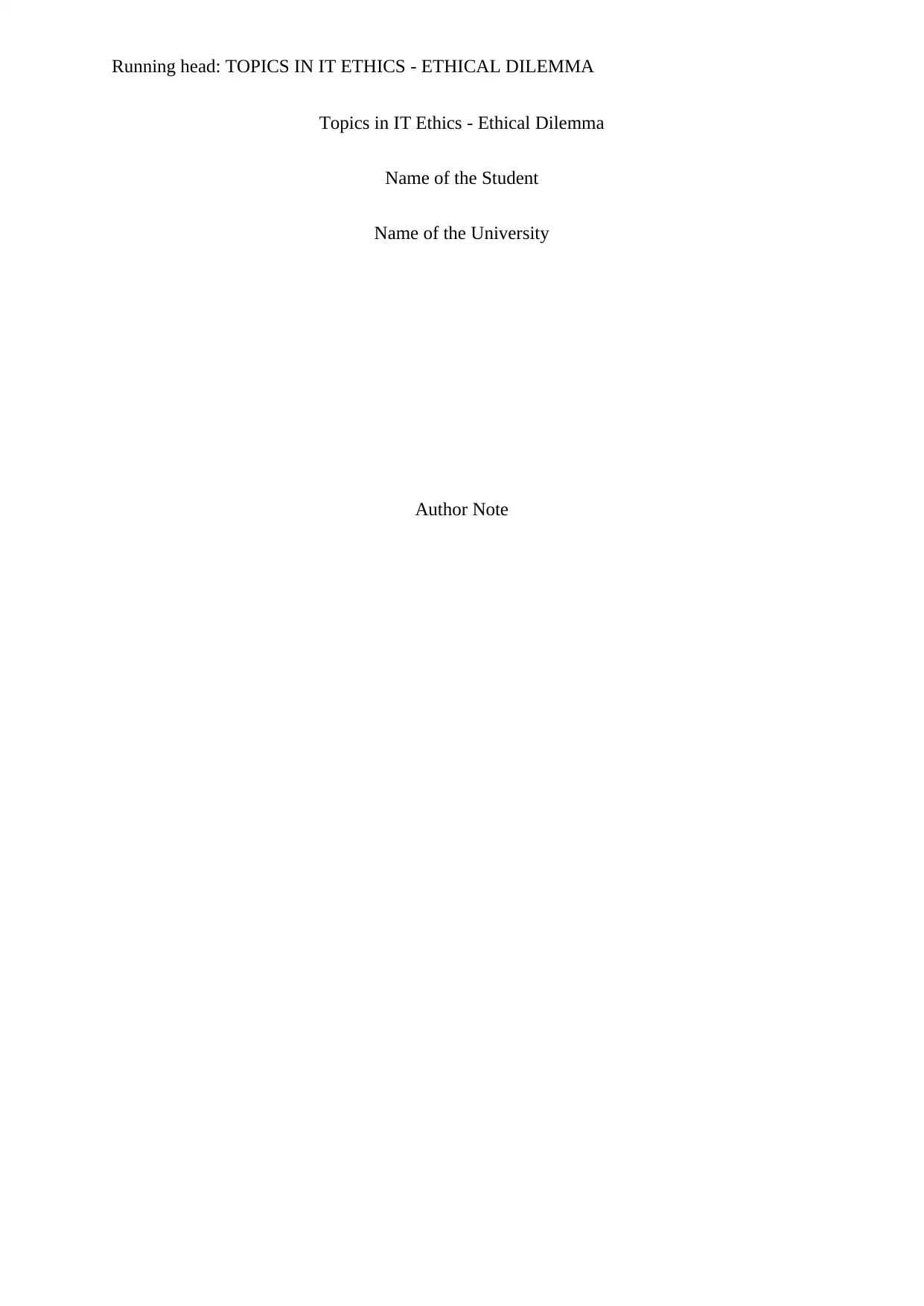
Running head: TOPICS IN IT ETHICS - ETHICAL DILEMMA
Topics in IT Ethics - Ethical Dilemma
Name of the Student
Name of the University
Author Note
Topics in IT Ethics - Ethical Dilemma
Name of the Student
Name of the University
Author Note
Paraphrase This Document
Need a fresh take? Get an instant paraphrase of this document with our AI Paraphraser
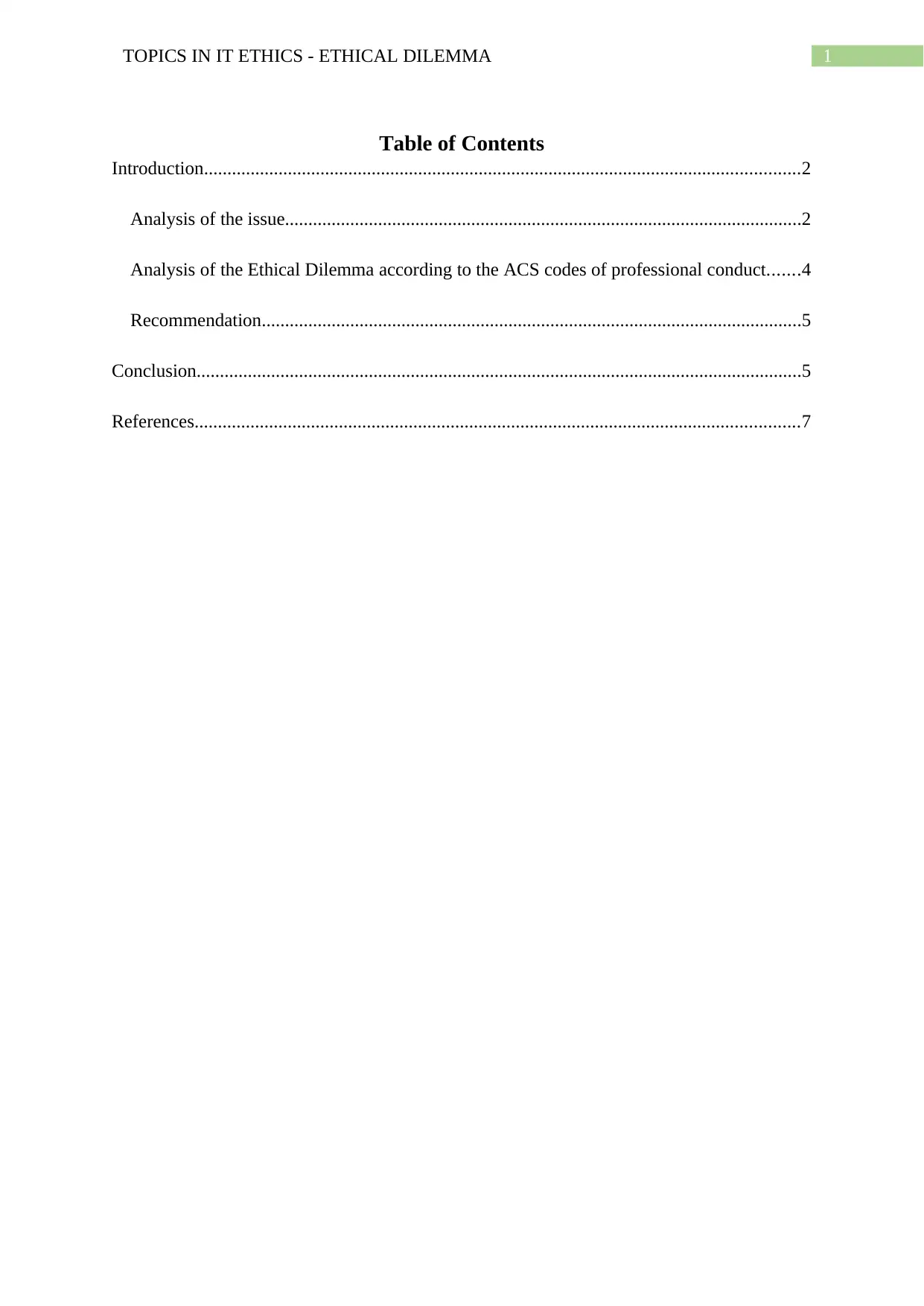
1TOPICS IN IT ETHICS - ETHICAL DILEMMA
Table of Contents
Introduction................................................................................................................................2
Analysis of the issue...............................................................................................................2
Analysis of the Ethical Dilemma according to the ACS codes of professional conduct.......4
Recommendation....................................................................................................................5
Conclusion..................................................................................................................................5
References..................................................................................................................................7
Table of Contents
Introduction................................................................................................................................2
Analysis of the issue...............................................................................................................2
Analysis of the Ethical Dilemma according to the ACS codes of professional conduct.......4
Recommendation....................................................................................................................5
Conclusion..................................................................................................................................5
References..................................................................................................................................7
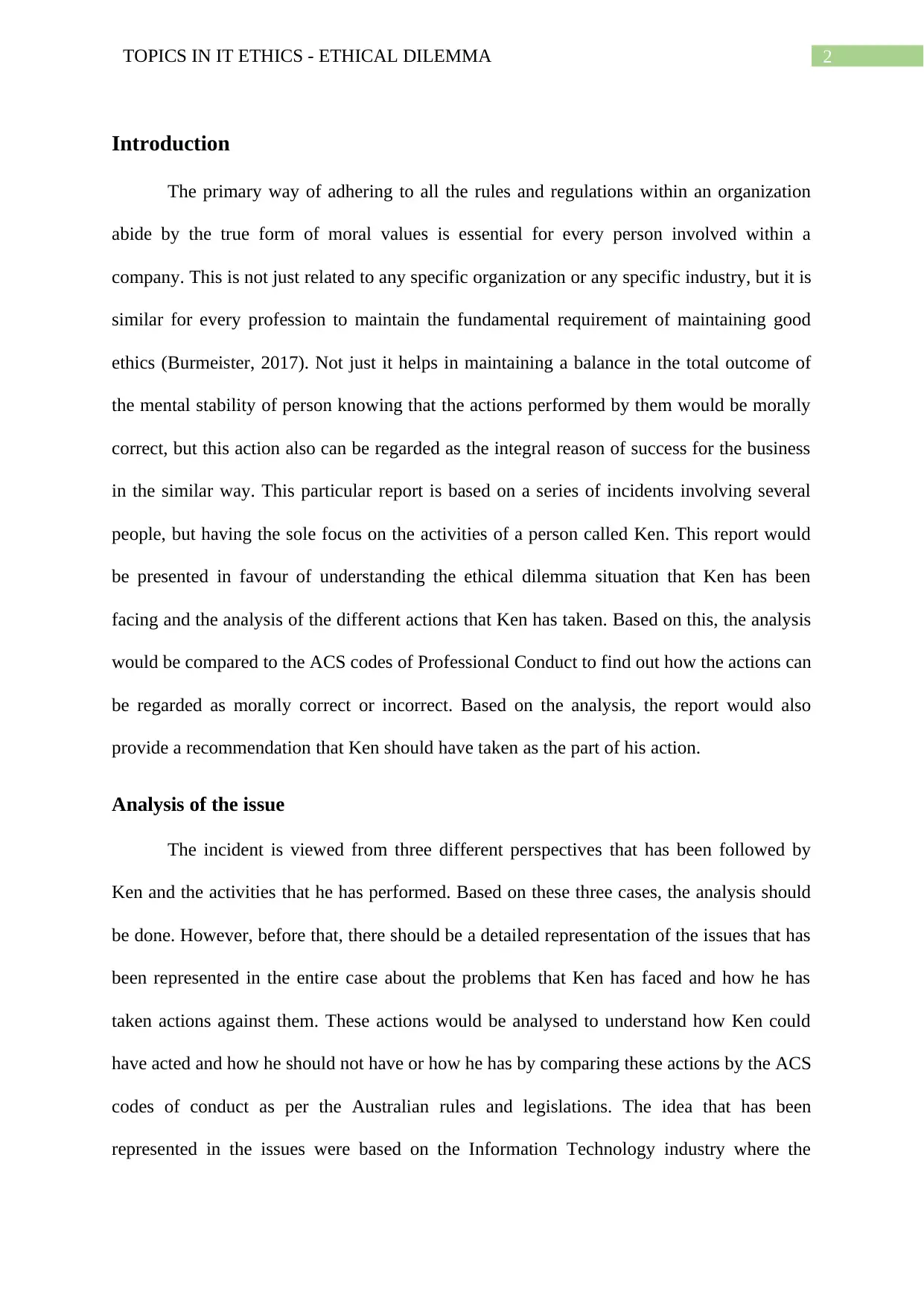
2TOPICS IN IT ETHICS - ETHICAL DILEMMA
Introduction
The primary way of adhering to all the rules and regulations within an organization
abide by the true form of moral values is essential for every person involved within a
company. This is not just related to any specific organization or any specific industry, but it is
similar for every profession to maintain the fundamental requirement of maintaining good
ethics (Burmeister, 2017). Not just it helps in maintaining a balance in the total outcome of
the mental stability of person knowing that the actions performed by them would be morally
correct, but this action also can be regarded as the integral reason of success for the business
in the similar way. This particular report is based on a series of incidents involving several
people, but having the sole focus on the activities of a person called Ken. This report would
be presented in favour of understanding the ethical dilemma situation that Ken has been
facing and the analysis of the different actions that Ken has taken. Based on this, the analysis
would be compared to the ACS codes of Professional Conduct to find out how the actions can
be regarded as morally correct or incorrect. Based on the analysis, the report would also
provide a recommendation that Ken should have taken as the part of his action.
Analysis of the issue
The incident is viewed from three different perspectives that has been followed by
Ken and the activities that he has performed. Based on these three cases, the analysis should
be done. However, before that, there should be a detailed representation of the issues that has
been represented in the entire case about the problems that Ken has faced and how he has
taken actions against them. These actions would be analysed to understand how Ken could
have acted and how he should not have or how he has by comparing these actions by the ACS
codes of conduct as per the Australian rules and legislations. The idea that has been
represented in the issues were based on the Information Technology industry where the
Introduction
The primary way of adhering to all the rules and regulations within an organization
abide by the true form of moral values is essential for every person involved within a
company. This is not just related to any specific organization or any specific industry, but it is
similar for every profession to maintain the fundamental requirement of maintaining good
ethics (Burmeister, 2017). Not just it helps in maintaining a balance in the total outcome of
the mental stability of person knowing that the actions performed by them would be morally
correct, but this action also can be regarded as the integral reason of success for the business
in the similar way. This particular report is based on a series of incidents involving several
people, but having the sole focus on the activities of a person called Ken. This report would
be presented in favour of understanding the ethical dilemma situation that Ken has been
facing and the analysis of the different actions that Ken has taken. Based on this, the analysis
would be compared to the ACS codes of Professional Conduct to find out how the actions can
be regarded as morally correct or incorrect. Based on the analysis, the report would also
provide a recommendation that Ken should have taken as the part of his action.
Analysis of the issue
The incident is viewed from three different perspectives that has been followed by
Ken and the activities that he has performed. Based on these three cases, the analysis should
be done. However, before that, there should be a detailed representation of the issues that has
been represented in the entire case about the problems that Ken has faced and how he has
taken actions against them. These actions would be analysed to understand how Ken could
have acted and how he should not have or how he has by comparing these actions by the ACS
codes of conduct as per the Australian rules and legislations. The idea that has been
represented in the issues were based on the Information Technology industry where the
⊘ This is a preview!⊘
Do you want full access?
Subscribe today to unlock all pages.

Trusted by 1+ million students worldwide
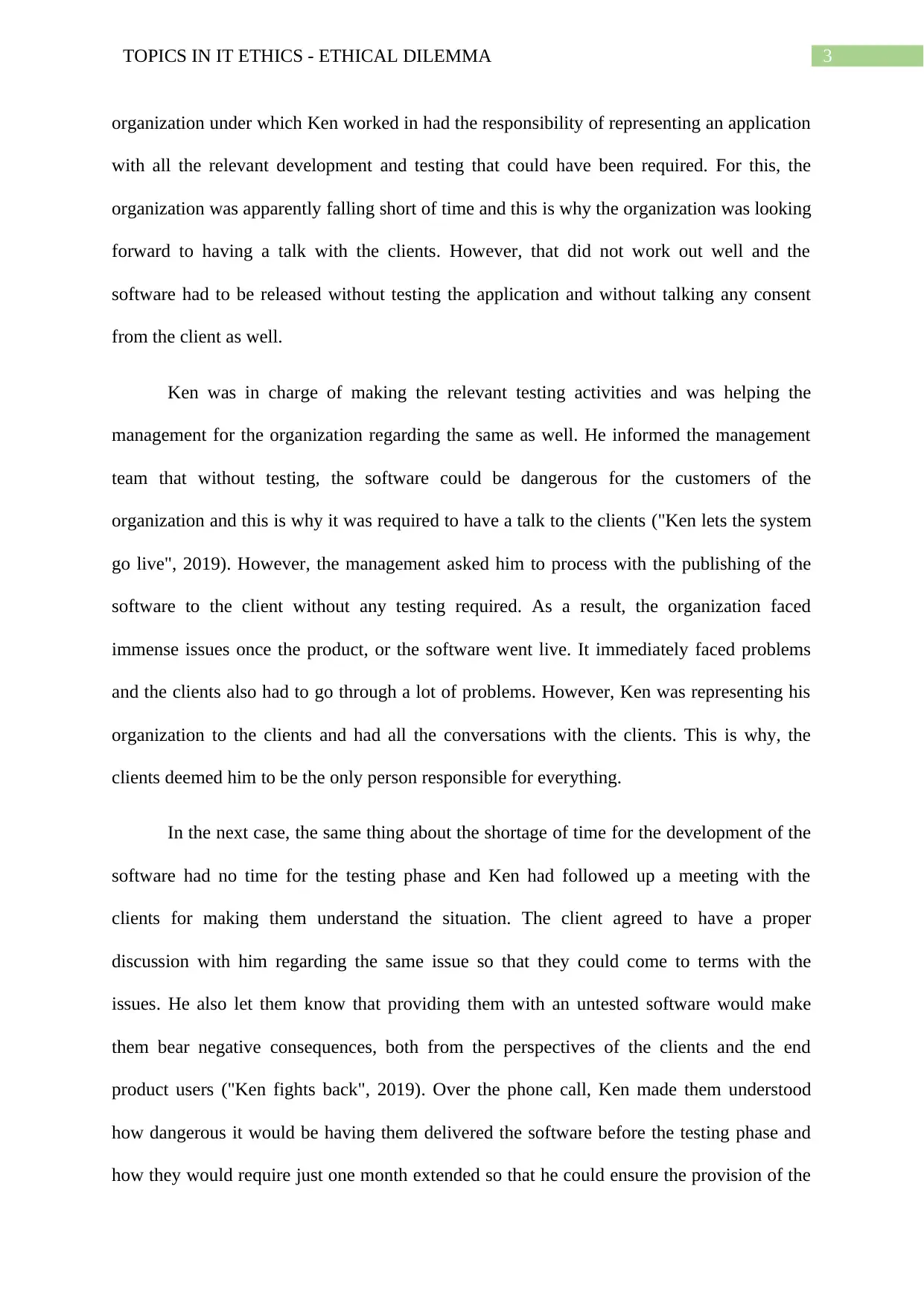
3TOPICS IN IT ETHICS - ETHICAL DILEMMA
organization under which Ken worked in had the responsibility of representing an application
with all the relevant development and testing that could have been required. For this, the
organization was apparently falling short of time and this is why the organization was looking
forward to having a talk with the clients. However, that did not work out well and the
software had to be released without testing the application and without talking any consent
from the client as well.
Ken was in charge of making the relevant testing activities and was helping the
management for the organization regarding the same as well. He informed the management
team that without testing, the software could be dangerous for the customers of the
organization and this is why it was required to have a talk to the clients ("Ken lets the system
go live", 2019). However, the management asked him to process with the publishing of the
software to the client without any testing required. As a result, the organization faced
immense issues once the product, or the software went live. It immediately faced problems
and the clients also had to go through a lot of problems. However, Ken was representing his
organization to the clients and had all the conversations with the clients. This is why, the
clients deemed him to be the only person responsible for everything.
In the next case, the same thing about the shortage of time for the development of the
software had no time for the testing phase and Ken had followed up a meeting with the
clients for making them understand the situation. The client agreed to have a proper
discussion with him regarding the same issue so that they could come to terms with the
issues. He also let them know that providing them with an untested software would make
them bear negative consequences, both from the perspectives of the clients and the end
product users ("Ken fights back", 2019). Over the phone call, Ken made them understood
how dangerous it would be having them delivered the software before the testing phase and
how they would require just one month extended so that he could ensure the provision of the
organization under which Ken worked in had the responsibility of representing an application
with all the relevant development and testing that could have been required. For this, the
organization was apparently falling short of time and this is why the organization was looking
forward to having a talk with the clients. However, that did not work out well and the
software had to be released without testing the application and without talking any consent
from the client as well.
Ken was in charge of making the relevant testing activities and was helping the
management for the organization regarding the same as well. He informed the management
team that without testing, the software could be dangerous for the customers of the
organization and this is why it was required to have a talk to the clients ("Ken lets the system
go live", 2019). However, the management asked him to process with the publishing of the
software to the client without any testing required. As a result, the organization faced
immense issues once the product, or the software went live. It immediately faced problems
and the clients also had to go through a lot of problems. However, Ken was representing his
organization to the clients and had all the conversations with the clients. This is why, the
clients deemed him to be the only person responsible for everything.
In the next case, the same thing about the shortage of time for the development of the
software had no time for the testing phase and Ken had followed up a meeting with the
clients for making them understand the situation. The client agreed to have a proper
discussion with him regarding the same issue so that they could come to terms with the
issues. He also let them know that providing them with an untested software would make
them bear negative consequences, both from the perspectives of the clients and the end
product users ("Ken fights back", 2019). Over the phone call, Ken made them understood
how dangerous it would be having them delivered the software before the testing phase and
how they would require just one month extended so that he could ensure the provision of the
Paraphrase This Document
Need a fresh take? Get an instant paraphrase of this document with our AI Paraphraser
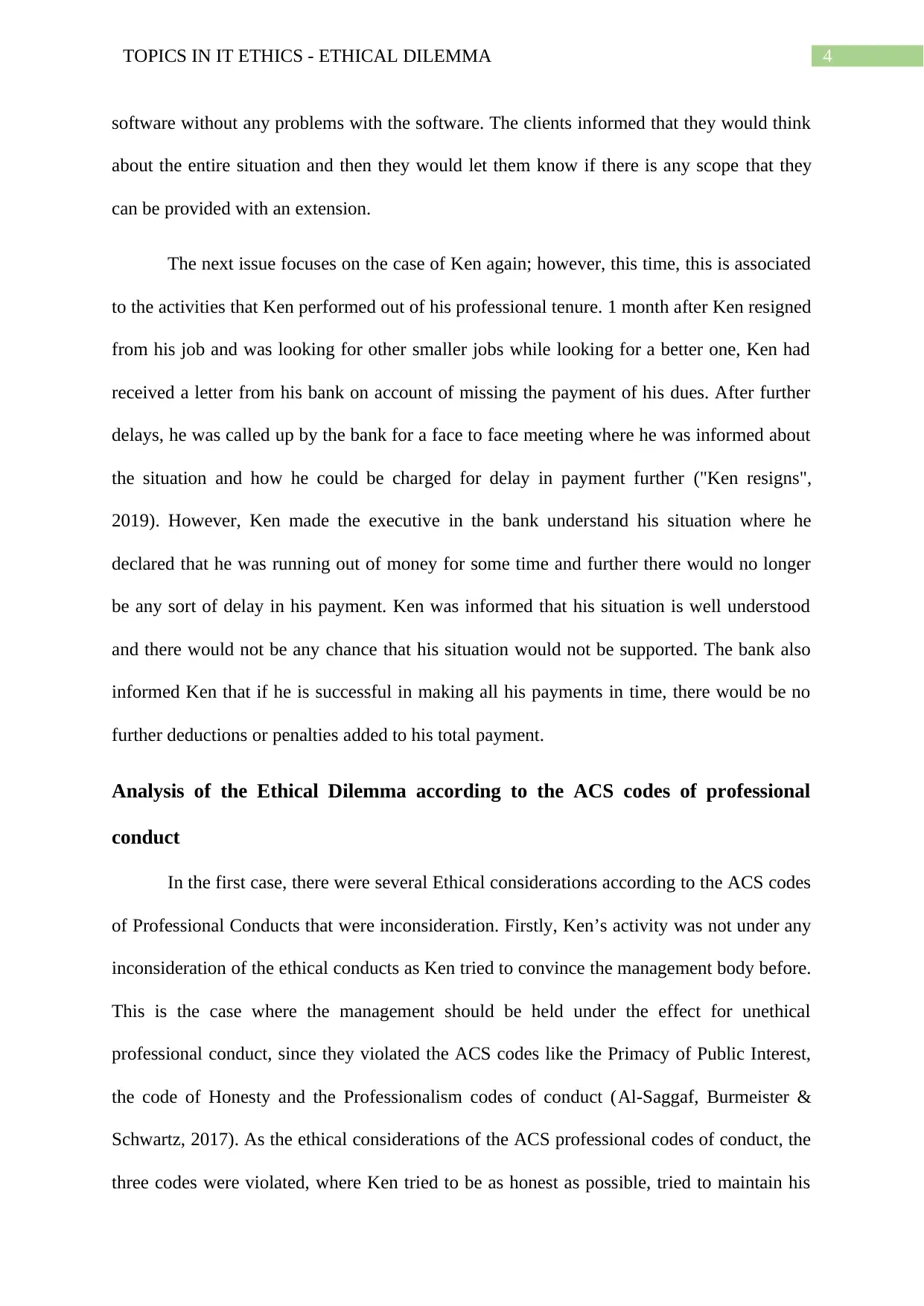
4TOPICS IN IT ETHICS - ETHICAL DILEMMA
software without any problems with the software. The clients informed that they would think
about the entire situation and then they would let them know if there is any scope that they
can be provided with an extension.
The next issue focuses on the case of Ken again; however, this time, this is associated
to the activities that Ken performed out of his professional tenure. 1 month after Ken resigned
from his job and was looking for other smaller jobs while looking for a better one, Ken had
received a letter from his bank on account of missing the payment of his dues. After further
delays, he was called up by the bank for a face to face meeting where he was informed about
the situation and how he could be charged for delay in payment further ("Ken resigns",
2019). However, Ken made the executive in the bank understand his situation where he
declared that he was running out of money for some time and further there would no longer
be any sort of delay in his payment. Ken was informed that his situation is well understood
and there would not be any chance that his situation would not be supported. The bank also
informed Ken that if he is successful in making all his payments in time, there would be no
further deductions or penalties added to his total payment.
Analysis of the Ethical Dilemma according to the ACS codes of professional
conduct
In the first case, there were several Ethical considerations according to the ACS codes
of Professional Conducts that were inconsideration. Firstly, Ken’s activity was not under any
inconsideration of the ethical conducts as Ken tried to convince the management body before.
This is the case where the management should be held under the effect for unethical
professional conduct, since they violated the ACS codes like the Primacy of Public Interest,
the code of Honesty and the Professionalism codes of conduct (Al-Saggaf, Burmeister &
Schwartz, 2017). As the ethical considerations of the ACS professional codes of conduct, the
three codes were violated, where Ken tried to be as honest as possible, tried to maintain his
software without any problems with the software. The clients informed that they would think
about the entire situation and then they would let them know if there is any scope that they
can be provided with an extension.
The next issue focuses on the case of Ken again; however, this time, this is associated
to the activities that Ken performed out of his professional tenure. 1 month after Ken resigned
from his job and was looking for other smaller jobs while looking for a better one, Ken had
received a letter from his bank on account of missing the payment of his dues. After further
delays, he was called up by the bank for a face to face meeting where he was informed about
the situation and how he could be charged for delay in payment further ("Ken resigns",
2019). However, Ken made the executive in the bank understand his situation where he
declared that he was running out of money for some time and further there would no longer
be any sort of delay in his payment. Ken was informed that his situation is well understood
and there would not be any chance that his situation would not be supported. The bank also
informed Ken that if he is successful in making all his payments in time, there would be no
further deductions or penalties added to his total payment.
Analysis of the Ethical Dilemma according to the ACS codes of professional
conduct
In the first case, there were several Ethical considerations according to the ACS codes
of Professional Conducts that were inconsideration. Firstly, Ken’s activity was not under any
inconsideration of the ethical conducts as Ken tried to convince the management body before.
This is the case where the management should be held under the effect for unethical
professional conduct, since they violated the ACS codes like the Primacy of Public Interest,
the code of Honesty and the Professionalism codes of conduct (Al-Saggaf, Burmeister &
Schwartz, 2017). As the ethical considerations of the ACS professional codes of conduct, the
three codes were violated, where Ken tried to be as honest as possible, tried to maintain his
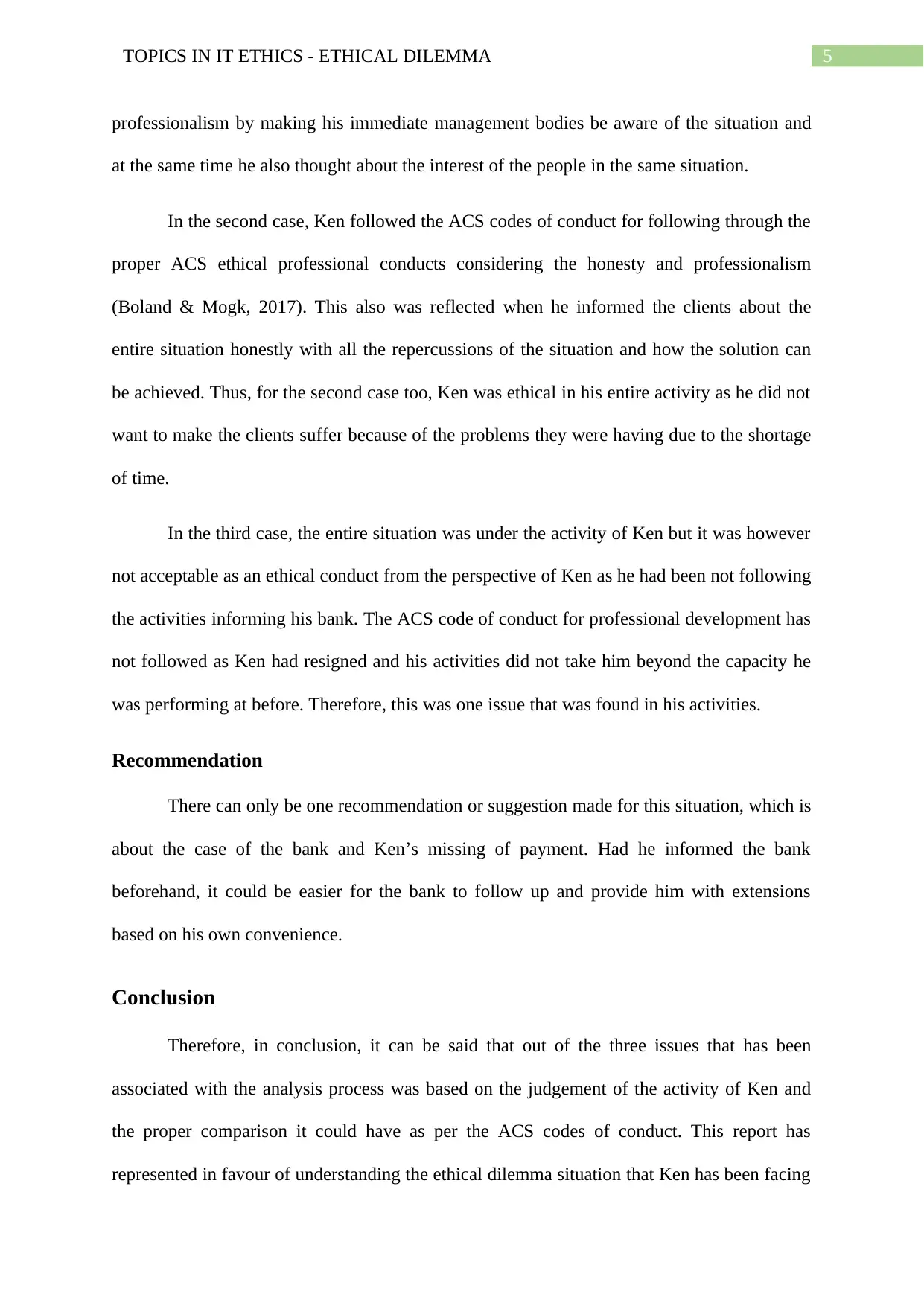
5TOPICS IN IT ETHICS - ETHICAL DILEMMA
professionalism by making his immediate management bodies be aware of the situation and
at the same time he also thought about the interest of the people in the same situation.
In the second case, Ken followed the ACS codes of conduct for following through the
proper ACS ethical professional conducts considering the honesty and professionalism
(Boland & Mogk, 2017). This also was reflected when he informed the clients about the
entire situation honestly with all the repercussions of the situation and how the solution can
be achieved. Thus, for the second case too, Ken was ethical in his entire activity as he did not
want to make the clients suffer because of the problems they were having due to the shortage
of time.
In the third case, the entire situation was under the activity of Ken but it was however
not acceptable as an ethical conduct from the perspective of Ken as he had been not following
the activities informing his bank. The ACS code of conduct for professional development has
not followed as Ken had resigned and his activities did not take him beyond the capacity he
was performing at before. Therefore, this was one issue that was found in his activities.
Recommendation
There can only be one recommendation or suggestion made for this situation, which is
about the case of the bank and Ken’s missing of payment. Had he informed the bank
beforehand, it could be easier for the bank to follow up and provide him with extensions
based on his own convenience.
Conclusion
Therefore, in conclusion, it can be said that out of the three issues that has been
associated with the analysis process was based on the judgement of the activity of Ken and
the proper comparison it could have as per the ACS codes of conduct. This report has
represented in favour of understanding the ethical dilemma situation that Ken has been facing
professionalism by making his immediate management bodies be aware of the situation and
at the same time he also thought about the interest of the people in the same situation.
In the second case, Ken followed the ACS codes of conduct for following through the
proper ACS ethical professional conducts considering the honesty and professionalism
(Boland & Mogk, 2017). This also was reflected when he informed the clients about the
entire situation honestly with all the repercussions of the situation and how the solution can
be achieved. Thus, for the second case too, Ken was ethical in his entire activity as he did not
want to make the clients suffer because of the problems they were having due to the shortage
of time.
In the third case, the entire situation was under the activity of Ken but it was however
not acceptable as an ethical conduct from the perspective of Ken as he had been not following
the activities informing his bank. The ACS code of conduct for professional development has
not followed as Ken had resigned and his activities did not take him beyond the capacity he
was performing at before. Therefore, this was one issue that was found in his activities.
Recommendation
There can only be one recommendation or suggestion made for this situation, which is
about the case of the bank and Ken’s missing of payment. Had he informed the bank
beforehand, it could be easier for the bank to follow up and provide him with extensions
based on his own convenience.
Conclusion
Therefore, in conclusion, it can be said that out of the three issues that has been
associated with the analysis process was based on the judgement of the activity of Ken and
the proper comparison it could have as per the ACS codes of conduct. This report has
represented in favour of understanding the ethical dilemma situation that Ken has been facing
⊘ This is a preview!⊘
Do you want full access?
Subscribe today to unlock all pages.

Trusted by 1+ million students worldwide
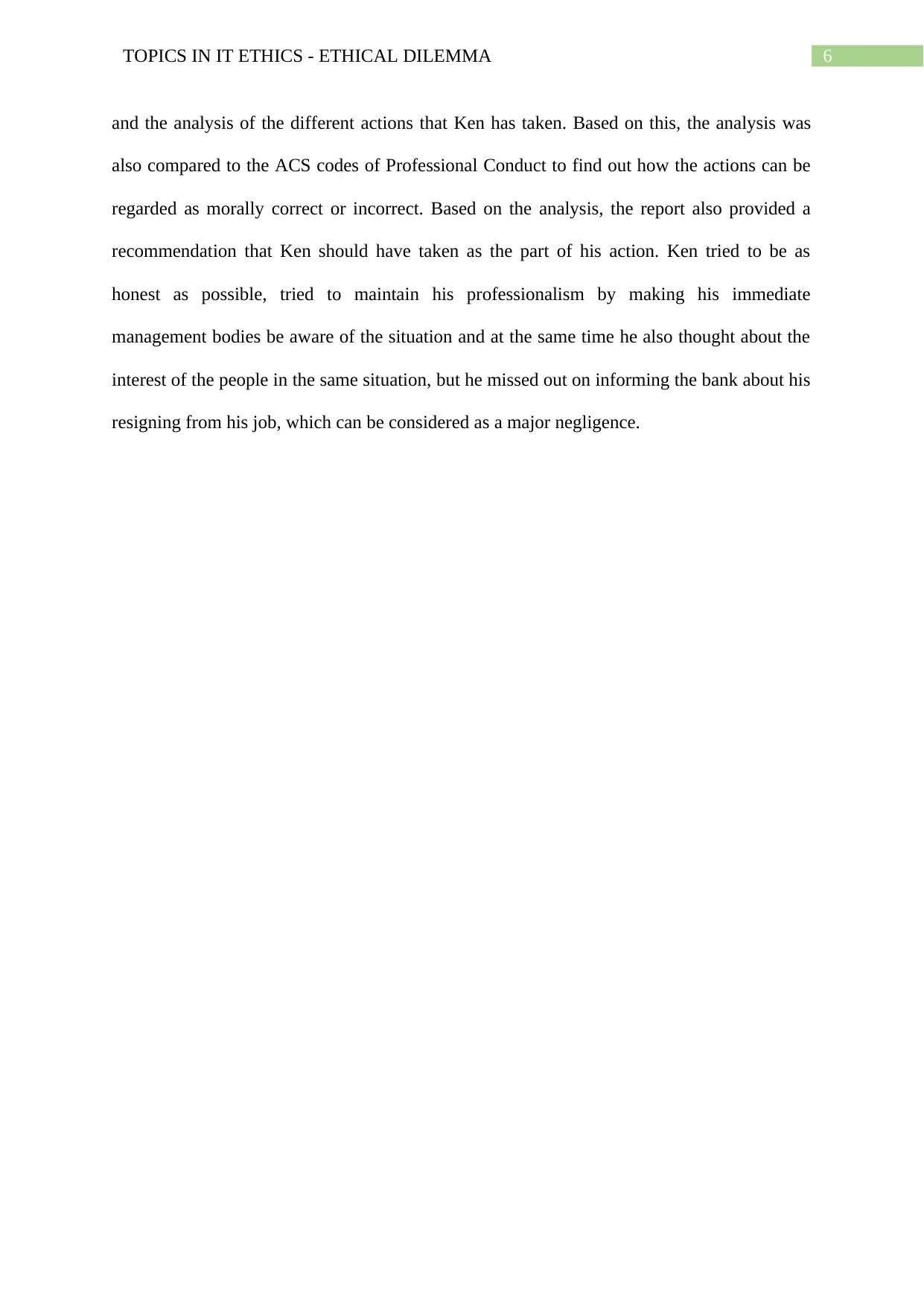
6TOPICS IN IT ETHICS - ETHICAL DILEMMA
and the analysis of the different actions that Ken has taken. Based on this, the analysis was
also compared to the ACS codes of Professional Conduct to find out how the actions can be
regarded as morally correct or incorrect. Based on the analysis, the report also provided a
recommendation that Ken should have taken as the part of his action. Ken tried to be as
honest as possible, tried to maintain his professionalism by making his immediate
management bodies be aware of the situation and at the same time he also thought about the
interest of the people in the same situation, but he missed out on informing the bank about his
resigning from his job, which can be considered as a major negligence.
and the analysis of the different actions that Ken has taken. Based on this, the analysis was
also compared to the ACS codes of Professional Conduct to find out how the actions can be
regarded as morally correct or incorrect. Based on the analysis, the report also provided a
recommendation that Ken should have taken as the part of his action. Ken tried to be as
honest as possible, tried to maintain his professionalism by making his immediate
management bodies be aware of the situation and at the same time he also thought about the
interest of the people in the same situation, but he missed out on informing the bank about his
resigning from his job, which can be considered as a major negligence.
Paraphrase This Document
Need a fresh take? Get an instant paraphrase of this document with our AI Paraphraser
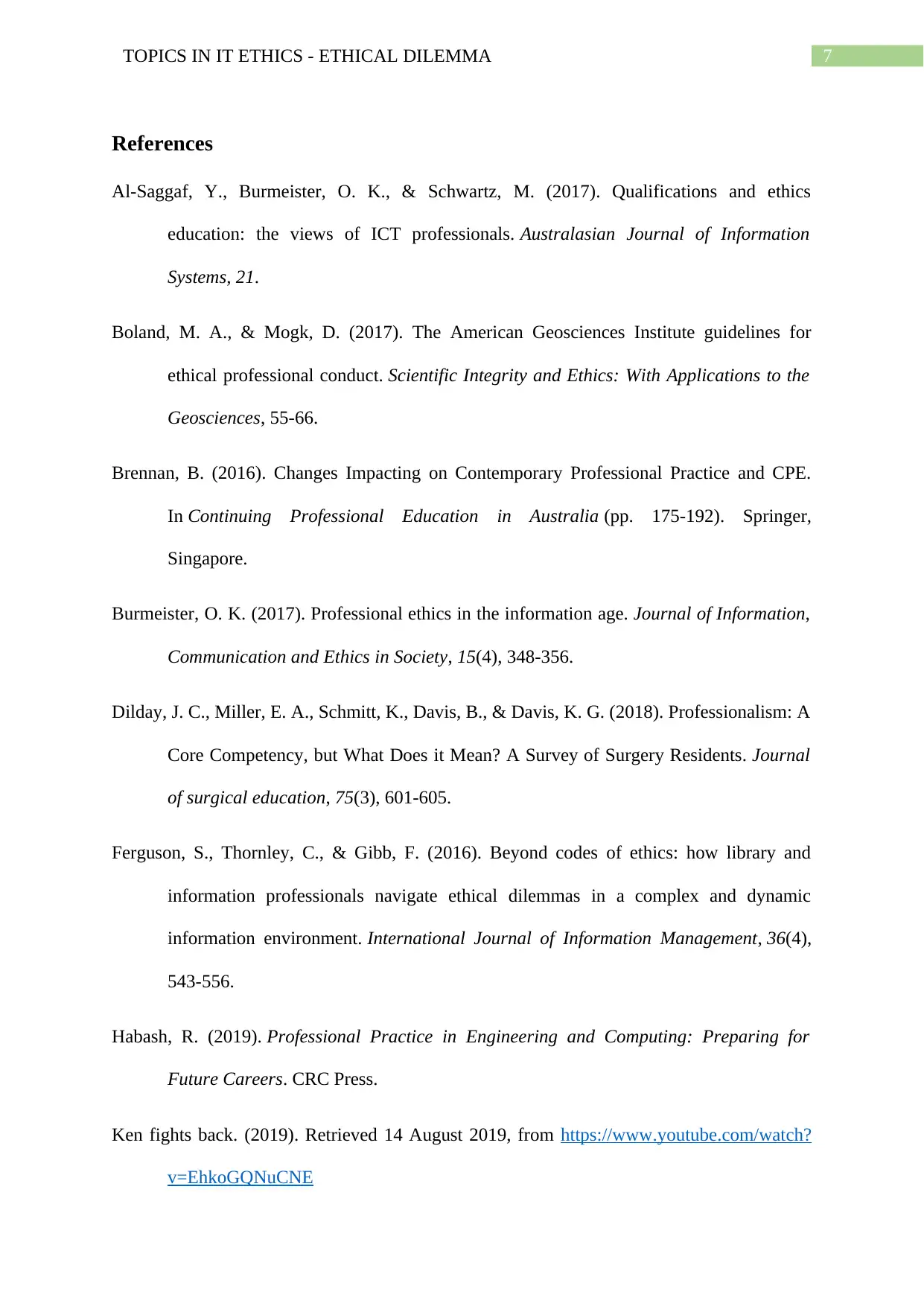
7TOPICS IN IT ETHICS - ETHICAL DILEMMA
References
Al-Saggaf, Y., Burmeister, O. K., & Schwartz, M. (2017). Qualifications and ethics
education: the views of ICT professionals. Australasian Journal of Information
Systems, 21.
Boland, M. A., & Mogk, D. (2017). The American Geosciences Institute guidelines for
ethical professional conduct. Scientific Integrity and Ethics: With Applications to the
Geosciences, 55-66.
Brennan, B. (2016). Changes Impacting on Contemporary Professional Practice and CPE.
In Continuing Professional Education in Australia (pp. 175-192). Springer,
Singapore.
Burmeister, O. K. (2017). Professional ethics in the information age. Journal of Information,
Communication and Ethics in Society, 15(4), 348-356.
Dilday, J. C., Miller, E. A., Schmitt, K., Davis, B., & Davis, K. G. (2018). Professionalism: A
Core Competency, but What Does it Mean? A Survey of Surgery Residents. Journal
of surgical education, 75(3), 601-605.
Ferguson, S., Thornley, C., & Gibb, F. (2016). Beyond codes of ethics: how library and
information professionals navigate ethical dilemmas in a complex and dynamic
information environment. International Journal of Information Management, 36(4),
543-556.
Habash, R. (2019). Professional Practice in Engineering and Computing: Preparing for
Future Careers. CRC Press.
Ken fights back. (2019). Retrieved 14 August 2019, from https://www.youtube.com/watch?
v=EhkoGQNuCNE
References
Al-Saggaf, Y., Burmeister, O. K., & Schwartz, M. (2017). Qualifications and ethics
education: the views of ICT professionals. Australasian Journal of Information
Systems, 21.
Boland, M. A., & Mogk, D. (2017). The American Geosciences Institute guidelines for
ethical professional conduct. Scientific Integrity and Ethics: With Applications to the
Geosciences, 55-66.
Brennan, B. (2016). Changes Impacting on Contemporary Professional Practice and CPE.
In Continuing Professional Education in Australia (pp. 175-192). Springer,
Singapore.
Burmeister, O. K. (2017). Professional ethics in the information age. Journal of Information,
Communication and Ethics in Society, 15(4), 348-356.
Dilday, J. C., Miller, E. A., Schmitt, K., Davis, B., & Davis, K. G. (2018). Professionalism: A
Core Competency, but What Does it Mean? A Survey of Surgery Residents. Journal
of surgical education, 75(3), 601-605.
Ferguson, S., Thornley, C., & Gibb, F. (2016). Beyond codes of ethics: how library and
information professionals navigate ethical dilemmas in a complex and dynamic
information environment. International Journal of Information Management, 36(4),
543-556.
Habash, R. (2019). Professional Practice in Engineering and Computing: Preparing for
Future Careers. CRC Press.
Ken fights back. (2019). Retrieved 14 August 2019, from https://www.youtube.com/watch?
v=EhkoGQNuCNE
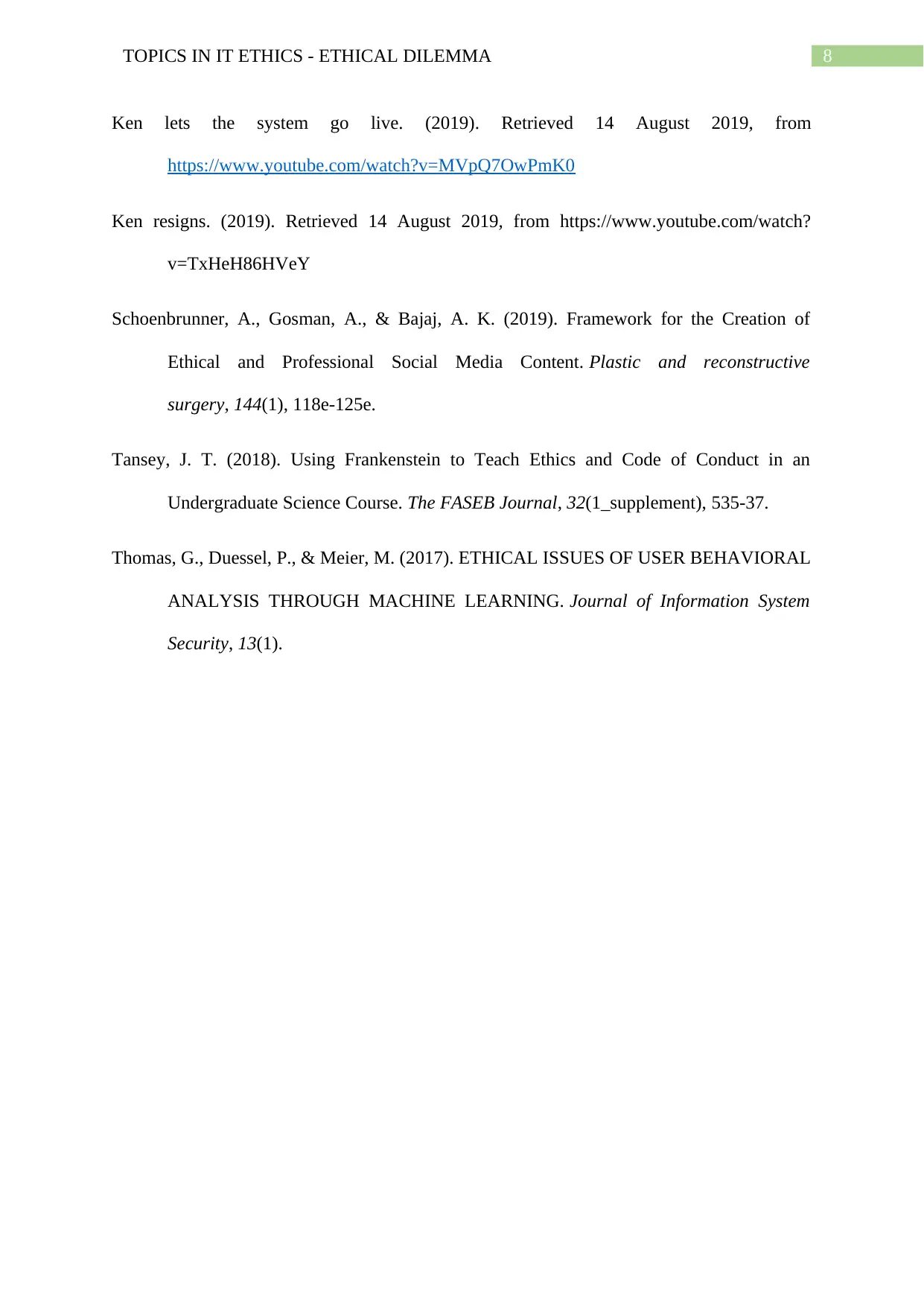
8TOPICS IN IT ETHICS - ETHICAL DILEMMA
Ken lets the system go live. (2019). Retrieved 14 August 2019, from
https://www.youtube.com/watch?v=MVpQ7OwPmK0
Ken resigns. (2019). Retrieved 14 August 2019, from https://www.youtube.com/watch?
v=TxHeH86HVeY
Schoenbrunner, A., Gosman, A., & Bajaj, A. K. (2019). Framework for the Creation of
Ethical and Professional Social Media Content. Plastic and reconstructive
surgery, 144(1), 118e-125e.
Tansey, J. T. (2018). Using Frankenstein to Teach Ethics and Code of Conduct in an
Undergraduate Science Course. The FASEB Journal, 32(1_supplement), 535-37.
Thomas, G., Duessel, P., & Meier, M. (2017). ETHICAL ISSUES OF USER BEHAVIORAL
ANALYSIS THROUGH MACHINE LEARNING. Journal of Information System
Security, 13(1).
Ken lets the system go live. (2019). Retrieved 14 August 2019, from
https://www.youtube.com/watch?v=MVpQ7OwPmK0
Ken resigns. (2019). Retrieved 14 August 2019, from https://www.youtube.com/watch?
v=TxHeH86HVeY
Schoenbrunner, A., Gosman, A., & Bajaj, A. K. (2019). Framework for the Creation of
Ethical and Professional Social Media Content. Plastic and reconstructive
surgery, 144(1), 118e-125e.
Tansey, J. T. (2018). Using Frankenstein to Teach Ethics and Code of Conduct in an
Undergraduate Science Course. The FASEB Journal, 32(1_supplement), 535-37.
Thomas, G., Duessel, P., & Meier, M. (2017). ETHICAL ISSUES OF USER BEHAVIORAL
ANALYSIS THROUGH MACHINE LEARNING. Journal of Information System
Security, 13(1).
⊘ This is a preview!⊘
Do you want full access?
Subscribe today to unlock all pages.

Trusted by 1+ million students worldwide
1 out of 9
Related Documents
Your All-in-One AI-Powered Toolkit for Academic Success.
+13062052269
info@desklib.com
Available 24*7 on WhatsApp / Email
![[object Object]](/_next/static/media/star-bottom.7253800d.svg)
Unlock your academic potential
Copyright © 2020–2025 A2Z Services. All Rights Reserved. Developed and managed by ZUCOL.



